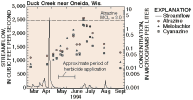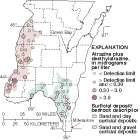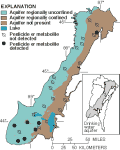Water Quality in the Western Lake Michigan Drainages, Wisconsin and Michigan, 1992-95
Table of contents || Previous section || Next section || Glossary
Fifteen pesticides were detected in ground water and 33 in surface water (Sullivan and Richards, 1996; Saad, 1996 and 1997). Most of the pesticides detected in surface water and ground water are herbicides used on corn, soy beans, small grains, and hay. However, there are a number of herbicides and insecticides, more commonly used on lawns and for specialty crops, that have been detected as well. The use of specific pesticides fluctuates over time as new pesticides are developed or as more information is ascertained regarding health effects and persistence.
 (55,317 bytes)
(55,317 bytes)
Approximately 1,100 tons of pesticide active ingredient are applied to agricultural land in the study area each year.
 (14,581 bytes)
(14,581 bytes)
Atrazine, the herbicide most commonly used on corn in the study area (Gianessi and Puffer, 1991) was detected in all of the stream samples and in more than half of the ground-water samples (Sullivan and Richards, 1996; Saad, 1996 and 1997). The herbicides simazine, metolachlor, cyanazine, prometon, and alachlor were detected in more than one-half of the stream samples.
Drinking-water standards (U.S. Environmental Protection Agency, 1996) were exceeded in only 11 of 143 surface-water samples. However, there are established standards for only about 20 percent of the 88 pesticides that were analyzed for as part of this study. There is no clear evidence that currently used pesticides are adversely effecting aquatic or human health; but at the same time, potential effects of long-term human and environmental exposure to both individual pesticides and to complex mixtures of pesticides and their degradation products are unknown (Goodbred and others, 1997; Girvin, 1996). The continuing presence of the once widely used insecticide DDT and its degradation products such as DDE, despite the ban on DDT use that was imposed in the early 1970s, demonstrates the persistence of certain toxic chemicals in the environment. Therefore, continued study of the types and amounts of pesticides in streams and ground water, coupled with the latest information on effects of pesticides on aquatic or human health, is in order.
Concentrations of pesticides were 100 times higher in intensively farmed (row crop) areas of the study area than in nonagricultural areas or in less intensively farmed areas where grazing, hay production, and less herbicide-intensive crops are raised.
Pesticide concentration in streams show a seasonal pattern (Sullivan and Richards, 1996). The highest pesticide concentrations typically occur during the first several periods of runoff following the application of pesticides.
Numerous pesticides have been detected in precipitation in the study area (Majewski and Capel, 1995). Atrazine concentrations in precipitation in the study area are typically about 0.2 µg/L (Goolsby and others, 1994). The presence of atrazine in stream water from the two forested Indicator Sites at concentrations less than 0.005 µg/L is probably due to atmospheric deposition.
 (8,237 bytes)
(8,237 bytes)
Pesticide concentrations are highest during storms that occur soon after the herbicide application period. Pesticide concentrations exceeded USEPA MCLs on several occasions during these runoff periods.
Pesticides applied at the land surface can be carried through the soil and subsoil to ground water with infiltrating rainfall. Pesticides were detected most frequently and in highest concentrations in ground water samples from shallow wells in intensively cultivated agricultural areas underlain by relatively permeable surficial deposits (Saad, 1997).
 (10,723 bytes)
(10,723 bytes)
Atrazine concentrations in shallow ground water were highest in areas with the most permeable surficial deposits. The shallow ground water targeted by these agricultural land use studies is seldom used for a drinking-water source.
Pesticides were also detected in deeper ground-water aquifers that are used as drinking-water supplies. Pesticides detected in the deep ground water are generally from areas where the aquifer is not covered by the relatively impermeable Sinnipee confining unit (Saad, 1996).
 (11,093 bytes)
(11,093 bytes)
Pesticides were detected in seven drinking-water aquifer wells. Most of the detections were in wells in agricultural areas where the aquifer is not covered by the Sinnipee confining unit (Saad, 1996).
U.S. Geological Survey Circular 1156
Table of contents || Previous section || Next section || Glossary
Suggested citation:
C. A. Peters, D. M. Robertson, D. A. Saad, D. J. Sullivan, B. C. Scudder, F. A. Fitzpatrick, K. D. Richards, J. S. Stewart, S. A. Fitzgerald, and B. N. Lenz, 1998, U.S. Geological Survey Circular 1156, on line at <URL: https://water.usgs.gov/pubs/circ1156>, updated June 11, 1998